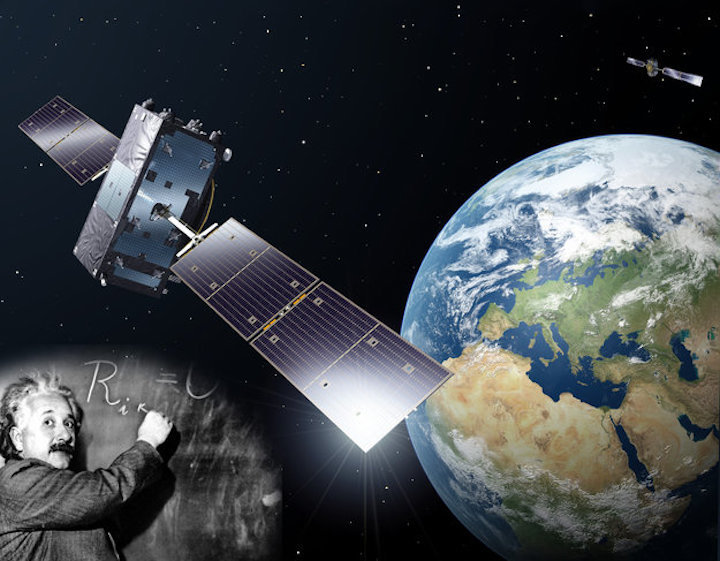5.12.2018

Europe’s Galileo satellite navigation system – already serving users globally – has now provided a historic service to the physics community worldwide, enabling the most accurate measurement ever made of how shifts in gravity alter the passing of time, a key element of Einstein’s Theory of General Relativity.
Two European fundamental physics teams working in parallel have independently achieved about a fivefold improvement in measuring accuracy of the gravity-driven time dilation effect known as ‘gravitational redshift’.
The prestigious Physical Review Letters journal has just published the independent results obtained from both consortiums, gathered from more than a thousand days of data obtained from the pair of Galileo satellites in elongated orbits.
“It is hugely satisfying for ESA to see that our original expectation that such results might be theoretically possible have now been borne out in practical terms, providing the first reported improvement of the gravitational redshift test for more than 40 years,” comments Javier Ventura-Traveset, Head of ESA’s Galileo Navigation Science Office.
“These extraordinary results have been made possible thanks to the unique features of the Galileo satellites, notably the very high stabilities of their onboard atomic clocks, the accuracies attainable in their orbit determination and the presence of laser-retroreflectors, which allow for the performance of independent and very precise orbit measurements from the ground, key to disentangle clock and orbit errors.”
These parallel research activities, known as GREAT (Galileo gravitational Redshift Experiment with eccentric sATellites), were led respectively by the SYRTE Observatoire de Paris in France and Germany’s ZARM Center of Applied Space Technology and Microgravity, coordinated by ESA’s Galileo Navigation Science Office and supported through its Basic Activities.
Happy results from an unhappy accident
These findings are the happy outcome of an unhappy accident: back in 2014 Galileo satellites 5 and 6 were stranded in incorrect orbits by a malfunctioning Soyuz upper stage, blocking their use for navigation. ESA flight controllers moved into action, performing a daring salvage in space to raise the low points of the satellites’ orbits and make them more circular.
Once the satellites achieved views of the whole Earth disc their antennas could be locked on their homeworld and their navigation payloads could indeed be switched on. The satellites are today in use as part of Galileo search and rescue services while their integration as part of nominal Galileo operations is currently under final assessment by ESA and the European Commission.
However, their orbits remain elliptical, with each satellite climbing and falling some 8500 km twice per day. It was these regular shifts in height, and therefore gravity levels, which made the satellites so valuable to the research teams.
Reenacting Einstein’s prediction
Albert Einstein predicted a century ago that time would pass more slowly close to a massive object, a finding that has since been verified experimentally several times – most significantly in 1976 when a hydrogen maser atomic clock on the Gravity Probe-A suborbital rocket was launched 10 000 km into space, confirming Einstein’s prediction to within 140 parts per million.
In fact, atomic clocks aboard navigation satellites must already take into account the fact that they run faster up in orbit than down on the ground – amounting to a few tenths of a microsecond per day, which would result in navigation errors of around 10 km daily, if uncorrected.
The two teams relied upon the stable timekeeping of the passive hydrogen maser (PHM) clocks aboard each Galileo – stable to one second in three million years – and kept from drifting by the worldwide Galileo ground segment.
“The fact that the Galileo satellites carry passive hydrogen maser clocks, was essential for the attainable accuracy of these tests,” noted Sven Hermann at the University of Bremen’s ZARM Center of Applied Space Technology and Microgravity.
“While every Galileo satellite carries two rubidium and two hydrogen maser clocks, only one of them is the active transmission clock. During our period of observation, we focus then on the periods of time when the satellites were transmitting with PHM clocks and assess the quality of these precious data very carefully. Ongoing improvements in the processing and in particular in the modelling of the clocks, might lead to tightened results in the future.”
Refining the results
A key challenge over three years of work was to refine the gravitational redshift measurements by eliminating systematic effects such as clock error and orbital drift due to factors such as Earth’s equatorial bulge, the influence of Earth’s magnetic field, temperature variations and even the subtle but persistent push of sunlight itself, known as ‘solar radiation pressure’.
“Careful and conservative modelling and control of these systematic errors has been essential, with stabilities down to four picoseconds over the 13 hours orbital period of the satellites; this is four millionth of one millionth of a second,” Pacôme Delva of SYRTE Observatoire de Paris.
“This required the support of many experts, with notably the expertise of ESA thanks to their knowledge of the Galileo system.”
Precise satellite tracking was enabled by the International Laser Ranging Service, shining lasers up to the Galileos’ retro-reflectors for centimetre-scale orbital checks.
Major support was also received from the Navigation Support Office based at ESA's ESOC operations centre in Germany, whose experts generated the reference stable clock and orbit products for the two Galileo eccentric satellites and also determined the residual errors of the orbits after the laser measurements.
Quelle: ESA







